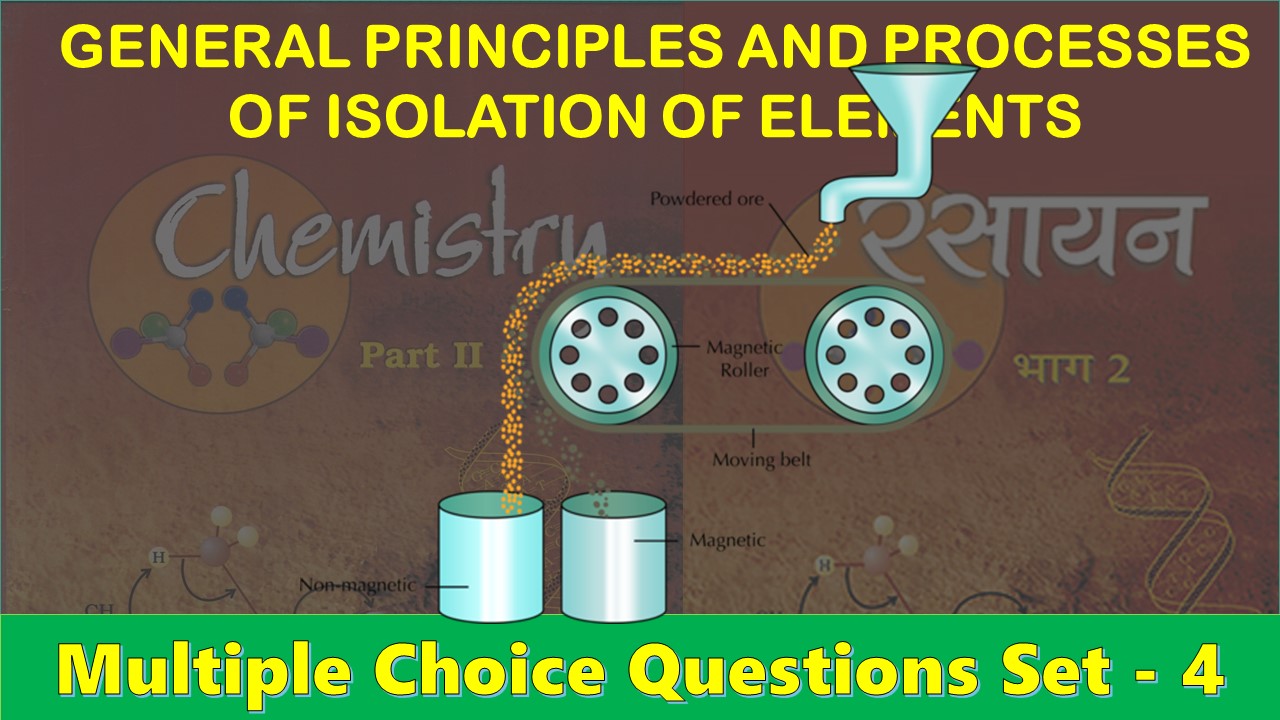CBSE Class 12 General Principles and Processes of Isolation of Elements Multiple Choice Questions with Answers. MCQ Questions Class 12 General Principles and Processes of Isolation of Elements with Answers Is Prepared Based on Latest Exam Pattern. Students can solve NCERT Class 12 General Principles and Processes of Isolation of Elements MCQs with Answers to know their preparation level.
Students who are searching for NCERT MCQ Questions for Class 12 General Principles and Processes of Isolation of Elements with Answers are compiled here to get good practice on all fundamentals. Know your preparation level on MCQ Questions for Class 12 General Principles and Processes of Isolation of Elements with Answers. You can also verify your answers from our provided MCQ Class 12 General Principles and Processes of Isolation of Elements with Answers. So, ace up your preparation with MCQ of Class 12 Chemistry Examinations.
MCQ Questions Class 12 General Principles and Processes of Isolation of Elements with Answers - Set - 4
Question 1:
The powdered ore is agitated with water or washed with running stream of water. The heavy ore particles and lighter impurities are separated. This method of concentration is known as
(a) metallurgy
(b) leaching
(c) froth floatation process
(d) gravity separation
Correct Answer – (D)
Question 2 :
Removal of the unwanted materials like sand, clays, etc. from the ore is known as ………., …….. or ……….
(a) concentration, dressing, benefaction
(b) separation, refining, gangue
(c) magnetic separation, purification, gangue
(d) washing, refining, amalgamation
Correct Answer – (A)
Question 3 :
Formula of copper pyrite is
(a)Cu2S
(b) CuFeS
(c) CuFeS2
(d) Cu2Fe2S2
Correct Answer – (C)
Question 4 :
Concentration of sulphide ore is done by
(a) froth flotation process
(b) electrolysis
(c) roasting
(d) None of these
Correct Answer – (A)
Question 5 :
The main reactions occurring in blast furnace during extraction of iron from haematite are________.
(i) Fe2O3 + 3CO → 2Fe + 3CO2
(ii) FeO + SiO2 → FeSiO3
(iii) Fe2O3 + 3C → 2Fe + 3CO
(iv) CaO + SiO2 → CaSiO3
(a) (i) and (iii)
(b) (ii) and (iv)
(c) (i) and (iv)
(d) (i), (ii) and (iii)
Correct Answer – (C)
MCQ Questions Class 12 General Principles and Processes of Isolation of Elements with Answers
Question 6:
For which of the following ores froth floatation method is used for concentration?
(a) Haematite
(b) Zinc blende
(c) Magnetite
(d) Camallite
Correct Answer – (B)
Question 7:
Ore of aluminium is
(a) bauxite
(b) hematite
(c) dolomite
(d) None of these
Correct Answer – (A)
Question 8:
Malachite is an ore of
(a) iron
(b) copper
(c) zinc
(d) Sliver
Correct Answer – (B)
Question 9:
2CuFeS2 +O2 →Cu2S + 2FeS + SO2 Which process of metallurgy of copper is represented by above equation?
(a) Concentration
(b) Roasting
(c) Reduction
(d) Purification
Correct Answer – (B)
Question 10:
Sulfide ores are common for the metals
(a) Ag, Cu and Pb
(c) Ag, Cu and Sn
(b) Ag, Mg and Pb
(d) Al, Cu and Pb
Correct Answer – (A)
- NCERT Solutions Class 11 Chemistry Chapter 1 : Some Basic Concepts of Chemistry
- NCERT Solutions Class 11 Chemistry Chapter 2 : Structure Of The Atom
- NCERT Solutions Class 11 Chemistry Chapter 3 : Classification of Elements and Periodicity in Properties
- NCERT Solutions Class 11 Chemistry Chapter 4 : Chemical Bonding and Molecular Structure
- NCERT Solutions Class 11 Chemistry Chapter 5 : States of Matter
- NCERT Solutions Class 11 Chemistry Chapter 6 : Thermodynamics
- NCERT Solutions Class 11 Chemistry Chapter 7 : Equilibrium
- NCERT Solutions Class 11 Chemistry Chapter 8 : Redox Reactions
- NCERT Solutions Class 11 Chemistry Chapter 9 : Hydrogen
- NCERT Solutions Class 11 Chemistry Chapter 10 : The s-Block Elements
- NCERT Solutions Class 11 Chemistry Chapter 11 : The p-Block Elements
- NCERT Solutions Class 11 Chemistry Chapter 12 : Organic Chemistry: Some Basic Principles and Techniques
- NCERT Solutions Class 11 Chemistry Chapter 13 : Hydrocarbons
- NCERT Solutions Class 11 Chemistry Chapter 14 : Environmental Chemistry



